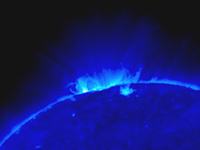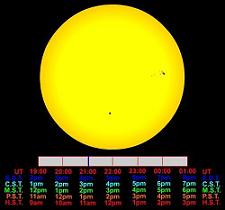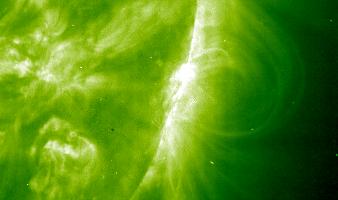
STEREO
Sees Comet McNaught (Mission
News- NASA) - January
12, 2007
This
image of Comet McNaught comes from the Heliospheric Imager on
one of the STEREO spacecraft, taken Jan. 11, 2007. To the right
is the comet nucleus, so bright it saturates the detector creating
a bright vertical band in the image. The comet's dynamic tails
extend up and to the left.
--2006--
First
Images From Hinode Offer New Clues About Our Violent Sun
(NASA News) - December
22, 2006
WASHINGTON
- Instruments aboard a Japan Aerospace Exploration Agency satellite
named Hinode, or "Sunrise," are returning extraordinary
new images of our sun. The international mission to study the
forces that drive the violent, explosive power of the sun launched
from Japan in September.
Scientists
Predict Big Solar Cycle (NASA Feature)
- December
21, 2006
Evidence
is mounting: the next solar cycle is going to be a big one.
 STEREO
Sends Back First Solar Images (Mission
News- NASA) - December
20, 2006 STEREO
Sends Back First Solar Images (Mission
News- NASA) - December
20, 2006
NASA's
twin Solar Terrestrial Relations Observatories (STEREO) sent
back their first images of the sun this week and with them a
view into the sun's mounting activity.
Space Station Glitch Possibly Caused by Solar Flare
(SPACE.com) - December
15, 2006
HOUSTON --
A glitch in the International Space Station’s (ISS) U.S.-built
attitude control system may have its root in a massive solar
flare that erupted from the Sun this week, a NASA flight director
said Friday.
2006
Transit of Mercury (NASA Feature)
- November
8, 2006
On
Wednesday, Nov 8, the planet Mercury passed directly in front
the Sun. What did it look like? A picture is worth a thousand
words.
First
Light for Hinode (NASA Feature) -
November 2, 2006
Get
ready for some fantastic images of the Sun. The Solar Optical
Telescope (SOT) onboard Japan's Hinode spacecraft has opened
its doors and started snapping pictures.
 2006
Transit of Mercury (NASA Feature)
- October
20, 2006 2006
Transit of Mercury (NASA Feature)
- October
20, 2006
Mark your
calendar: On Wednesday, Nov 8th, the planet Mercury will pass
directly in front the Sun. The transit begins at 2:12 pm EST
(11:12 am PST) and lasts for almost five hours. Good views can
be had from the Americas, Hawaii, Australia and all along the
Pacific Rim: visibility map.
Surprises
from the Edge of the Solar System
(NASA Feature) - September
21, 2006
Almost every
day, the great antennas of NASA's Deep Space Network turn to
a blank patch of sky in the constellation Ophiuchus. Pointing
at nothing, or so it seems, they invariably pick up a signal,
faint but full of intelligence. The source is beyond Neptune,
beyond Pluto, on the verge of the stars themselves.
Solar
Sentinels (NASA Feature)
- September
1, 2006
In his 1970s
book, Space, James Michener depicted a fictional Apollo
mission that lost its crew to radiation from a massive solar
flare. He based his tale on what easily might have been but
for lucky timing: a massive flare on Aug. 7, 1972 occurred between
Apollo 16 (April) and Apollo 17 (December), mankind's last journeys
to the Moon. The event still resonates today.
A
Summer Flare from the Sun to the Earth (NASA Feature)
- August 22, 2006
Scientists
say that the next solar cycle of activity is close-by; read
Backward
Sunspot to check out the sunspot that may be starting the
whole process. In
the meantime, this large sunspot, named Active Region 904, has
been sputtering on for days on end. After watching it rotate
into view on Aug. 9, it finally popped off a modest (C-class)
flare and associated coronal mass ejection (CME) on Aug. 17
when it had rotated into a location where it practically faced
Earth.
 Staying
a Step Ahead of the Sun (NASA Education Feature)
- August 17, 2006
Staying
a Step Ahead of the Sun (NASA Education Feature)
- August 17, 2006
NASA's
SOHO satellite looks deep inside the sun to better predict its
harmful impacts on Earth.
Educators
K-4
| 5-8
| 9-12
| Post
Secondary
Students 9-12
| Post
Secondary
Backward
Sunspot
(NASA Feature) - August 15, 2006
On July 31st,
a tiny sunspot was born. It popped up from the sun's interior,
floated around a bit, and vanished again in a few hours. On
the sun this sort of thing happens all the time and, ordinarily,
it wouldn't be worth mentioning. But this sunspot was special:
It was backward.
Flare
Ends Sun's Quiet Spell (NASA Featured Image)- July 7, 2006
After a long quiet spell without any strong solar
storms, the sun unleashed a flare (M-class, which means moderate)
and a fairly substantial coronal mass ejection on July 7.
 NASA
and NSF Computers Simulate Sun's Corona (NASA Feature)-
June
26, 2006 For
the first time, researchers have developed a computer simulation
that can accurately create a model of the sun's outer atmosphere,
or corona. Funded by NASA and the National Science Foundation,
the computer model marks the beginning of a new era in space
weather prediction. NASA
and NSF Computers Simulate Sun's Corona (NASA Feature)-
June
26, 2006 For
the first time, researchers have developed a computer simulation
that can accurately create a model of the sun's outer atmosphere,
or corona. Funded by NASA and the National Science Foundation,
the computer model marks the beginning of a new era in space
weather prediction.
For additional
information and graphics, visit: http://www.nasa.gov/vision/universe/solarsystem/corona_telecon.html
Long
Range Solar Forecast (NASA Feature)- May 10, 2006
The
Sun's "Great Conveyor Belt" has slowed to a record-low
crawl, which has important implications for future solar activity:
Solar Cycle 25 peaking in 2022 could be one of the weakest in
centuries.
NASA
Sees Eclipse in a Different Light
(NASA Feature)- March 27, 2006
It's
not easy to see a total solar eclipse. They're rare -- the next
one visible in the U.S. is in 2017 -- and you can't look directly
at them. But in the early morning hours of March 29, seeing the
next solar eclipse will be easy -- just visit this Web page.
+
VIEW VIDEO PREVIEW
 Solar
Storm Warning (NASA Feature)- March
15, 2006 Solar
Storm Warning (NASA Feature)- March
15, 2006
It's
official: Solar minimum has arrived. Sunspots have all but vanished.
Solar flares are nonexistent. The sun is utterly quiet.
Like
the quiet before a storm.
Recently
researchers announced that a storm is coming--the most intense
solar maximum in fifty years.
Solar
Storms: Nowhere to Hide from SOHO's Improved 'X-Ray Vision'
(NASA Feature)- March 9, 2006
NASA
researchers using the Solar and Heliospheric Observatory (SOHO)
spacecraft have developed a method of seeing through the sun to
the star's far side. The sun's far side faces away from the Earth,
so it is not directly observable by traditional techniques.
For
more information, see:
MDI
Full-Farside Description
Access
to new farside data
Solar
flares may pack a bigger punch (CNN.com)-
March 9, 2006
A
new computer model suggests the next solar cycle will be more
active than the previous one, potentially spawning magnetic storms
that will be more disruptive to communication systems on Earth.
 Scientists
Gaze Inside Sun, Predict Strength of the Next Solar Cycle
(NASA - Goddard Space Flight Center News)- March 6, 2006
Scientists
Gaze Inside Sun, Predict Strength of the Next Solar Cycle
(NASA - Goddard Space Flight Center News)- March 6, 2006
The
next solar activity cycle will be 30 to 50 percent stronger than
the previous one, and up to a year late in arriving, according
to a breakthrough forecast by Dr. Mausumi Dikpati and colleagues
at the National Center for Atmospheric Research (NCAR) in Boulder,
Colo. The scientists made the first "solar climate" forecast using
a combination of groundbreaking observations of the solar interior
from space and computer simulation. NASA's Living With a Star
program and the National Science Foundation funded the research.
Solar
Minimum has Arrived (NASA Feature)- March 6, 2006
Where
have all the sunspots gone? Solar minimum has arrived.
--2005--
Voyages
to the Sun (NASA- "Why We Explore")- December 2, 2005
Humanity's epic voyages to the Moon are well known, the stuff of
history. But what about voyages to the Sun? Though they do not involve
human spacecraft, those voyages are no less epic. And on the occasion
of the tenth anniversary of the launch of one of the most successful
voyages — is the Solar and Heliospheric Observatory, fondly
known as SOHO — it is fitting that we recall those voyages
to our life-giving star.
 Intrepid
Solar Spacecraft Celebrates 10th Anniversary (NASA Feature)-
November 29, 2005 Intrepid
Solar Spacecraft Celebrates 10th Anniversary (NASA Feature)-
November 29, 2005
The Solar and Heliospheric Observatory (SOHO) spacecraft celebrates
its 10th anniversary December 2. The SOHO mission, a collaboration
between NASA and the European Space Agency (ESA), has allowed scientists
to make significant advances in understanding the closest star,
our sun.
Sickening
Solar Flares (NASA press release)- November 8, 2005
When the biggest solar proton storm in 15 years erupted in January,
many were left wondering: what would have happened if astronauts
were on the moon?
An
Odd List of Body Parts (NASA press release)- October 26, 2005
Researchers are making a list: Which parts of an astronaut are most
sensitive to solar flares?
NASA's
Telescope for Students Reveals Record Solar Explosion Even More
Powerful (NASA press release)- October 14, 2005
Astronomers using an inexpensive NASA radio telescope kit for students
discovered that the record solar flare on November 4, 2003 was even
more powerful than originally estimated.
Who's
Afraid of a Solar Flare? (NASA press release)- October 7, 2005
Solar activity can be surprisingly good for astronauts.
Spacecraft
Pick up Earthly Aurora (NASA press release)- September 9, 2005
A coronal mass ejection (CME) hit Earth's magnetic field on Sept.
15, but it did not spark the strong display of auroras many people
were hoping to see. In the CME's wake, however, a fast solar wind
stream is blowing past Earth and buffeting our planet's magnetic
field. This could cause mild geomagnetic storms.
Huge
Solar Flares Continue (NASA press release)- September 7, 2005
Scientists are currently tracking a large sunspot that has so far
unleashed seven major solar flares including an X-17-category blast
on Sept. 7, an X-5 on Sept. 8, and an X-1 on Sept. 9. To say this
is powerful is an understatement; Wednesday's X-17 flare was the
fifth largest ever observed.
 Double
Solar Flare
(NASA feature)- August 22, 2005 Double
Solar Flare
(NASA feature)- August 22, 2005
Yesterday, Aug. 22, a pair of coronal mass ejections (CMEs) blasted
off the Sun and headed toward Earth. Geomagnetic storms and auroras
are possible today, Aug. 23 and tomorrow, Aug. 24 in Alaska and
Canada and possibly beyond.
Utah
bathed in pretty pink Aurora (The Register Article)-
August 22, 2005
Stargazers in Utah, Colorado, New York and other US states were
treated to a rare display in the early hours of this morning, when
the first of two large coronal mass ejections from the Sun collided
with the Earth's atmosphere, creating stunning Auroras.
Scientists
One Step Closer to Forecasting 'Clear Skies' for Astronauts
(NASA feature)- August
16, 2005
Scientists funded by NASA's Living With a Star program have
made a big stride forward in learning how to forecast "all
clear" periods where severe space weather is unlikely.
 Sun's
Temper Blamed for Arctic Ozone Loss (Live Science Article)-
March 1, 2005 Sun's
Temper Blamed for Arctic Ozone Loss (Live Science Article)-
March 1, 2005
A dramatic thinning of Earth's protective ozone layer above the
Arctic last year was the result of intense upper-level winds and
an extra dose of space weather, scientists said Tuesday.
Sickening
Solar Flares - January 27, 2005
The biggest solar proton storm in 15 years erupted last week.
NASA researchers discuss what it might have done to someone on the
Moon.
--2004--
Shields
Up! - September 27, 2004
A breeze of interstellar helium atoms is blowing through the solar
system.
--2003--
The
2003 Mercury Transit
- May 7,
2003
More
about the Mercury Transit - May
7, 2003
SOHO
Spies UFO? - January
17, 2003
Well,
ah, maybe not - January 17, 2003
The
Sun does the Wave - January 2, 2003
Wave-like Properties of Solar Supergranulation
--2002--
Man
on moon? How about Santa on sun? - December 26, 2002
A random arrangement of sunspots make the sun seem like a human
visage, which solar scientists could not resist transforming into
the most famous red face.
NASA
selects campus team to design, direct major solar experiment
- September 11, 2002
Massive
Filament Sighted
- July 17, 2002
Earth
at Perhelion
- June 17, 2002
Giant
loops in the solar atmopshere may trigger Sun's magnetic poles reversals
- June 2002
--1999--
"Cool"
microflares could be solar hot spots - June 1, 1999
Secret of coronal heating may be multitude of tiny blasts.
Finding
the 'smoking gun' before it fires - March 9, 1999
Physicists discover a new tool for predicting solar eruptions
'S'
marks the spot - March 9, 1999
Forecasting powerful solar explosions several days in advance may
now be possible
Orbiting
observatory SOHO finds source of high-speed "wind" blowing
from the Sun - February 3, 1999
--1998--
Twin
Comets Impact Sun - June 3, 1998
Solar
Flare Leaves Sun Quaking - May 27, 1998
Scientists have shown for the first time that solar flares produce
seismic waves, and gigantic seismic quakes, in the Sun's interior
Solar
Sounds Inspire Music - May, 27, 1998
--1997--
Solar
Mystery Nears Solution with Data from SOHO Spacecraft -
November 12, 1997
The Sun's Newly-discovered Magnetic Carpet May Explain Coronal Heating
Jet
Stream Runs Swiftly Inside the Sun - August 28, 1997
Water
on the Sun? - July 17, 1997
Researchers Confirm that Water Exists On The Sun
Face
on the Sun? - April 1, 1997
The King Lives on - in Sunspot Form!
|


 Scientists
Gaze Inside Sun, Predict Strength of the Next Solar Cycle
(NASA - Goddard Space Flight Center News)- March 6, 2006
Scientists
Gaze Inside Sun, Predict Strength of the Next Solar Cycle
(NASA - Goddard Space Flight Center News)- March 6, 2006






 Double
Solar Flare
Double
Solar Flare Sun's
Temper Blamed for Arctic Ozone Loss
Sun's
Temper Blamed for Arctic Ozone Loss